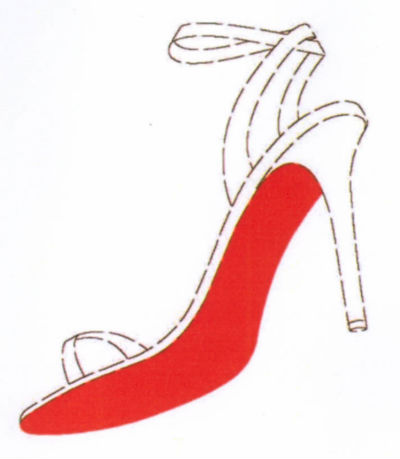On 12 June 2018 the European Court of Justice (CJEU) held that Louboutin’s red soles did not constitute a ‘shape’. This was a key finding under the rather technical rules relating to registered trade mark validity in the European Union. The practical result of the ruling was that Louboutin’s trade mark for the red sole could in principle be upheld as valid, and it is indeed expected to be upheld when the case goes back to the Dutch court for determination.
Below is the red sole as illustrated on the trade mark register.
The technical point
Under the EU Trade Mark Directive (2008/95), which applies to national registered trade marks throughout the EU, certain things can never be registered (or if registered are liable to be declared invalid). This includes marks “which consist exclusively of the shape which gives substantial value to the goods”. The Dutch court was of the view that the red sole did indeed give ‘substantial value to the goods’, because the colour formed part of the appearance of the shoes and played an important role in the consumer’s decision to buy them. This meant that if the sole was also to be regarded as a shape it would be invalid. This would be the case despite the mark’s massive reputation. Luckily for Louboutin, however, the CJEU said that it was not a shape, and even if it were a shape, it was not ‘exclusively’ a shape.
Implications of the case
There are two main points to bear in mind:
First, the law is changing. In the new Trade Mark Directive (EU 2015/2346), which must be implemented by Member States by 14 January 2019, the relevant provision has been amended and now refers to marks “which consist exclusively of …a shape or another characteristic which gives substantial value to the goods”. The question whether the colour of the sole can constitute “another characteristic” here has yet to be determined.
Secondly, even where the trade mark does not come within the specific exclusion it is generally very difficult to register trade marks which monopolise a colour, such as the red sole here. Substantial evidence of reputation and use will normally be needed. The mark may be regarded as a ‘position’ mark, the mark constituting the position of the colour on the product (the sole). However, position marks are also often difficult to obtain, as they may be regarded as non-distinctive and decorative rather than as indicating the commercial origin of the product. Again, substantial evidence of reputation and use may be needed.
So many challenges still remain for those contemplating registering marks of this kind.
For press comment on the decision by S&B's Elaine O'Hare, please see this page.

 Elaine O'Hare
Elaine O'Hare